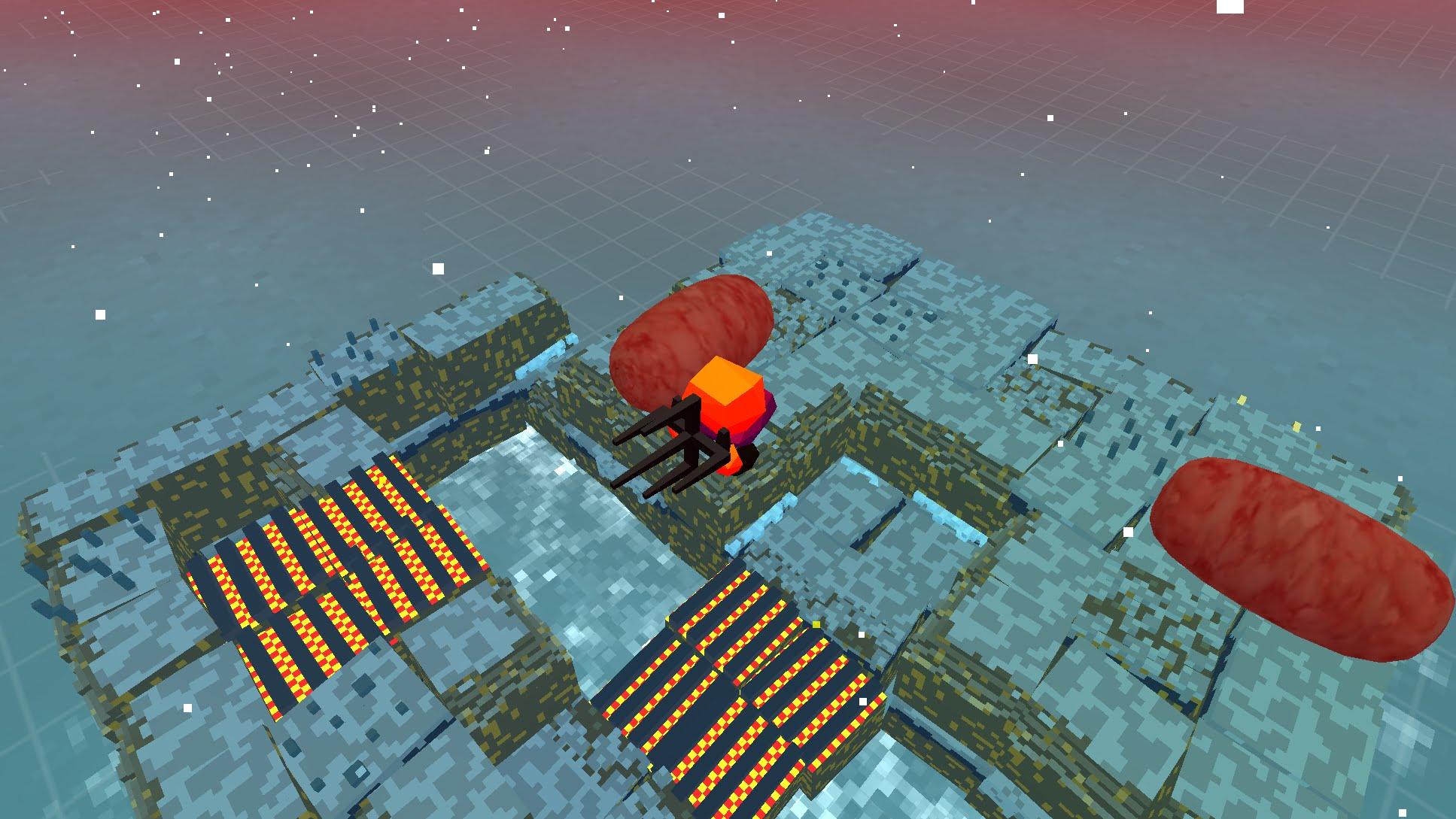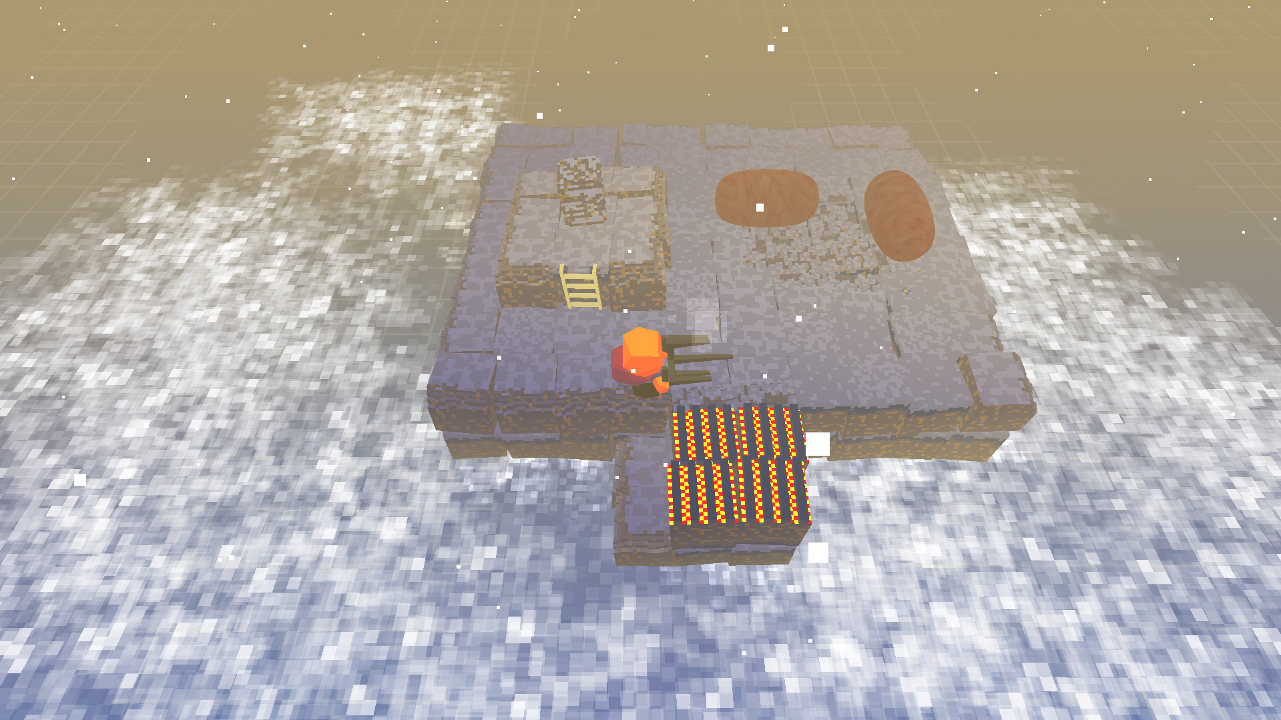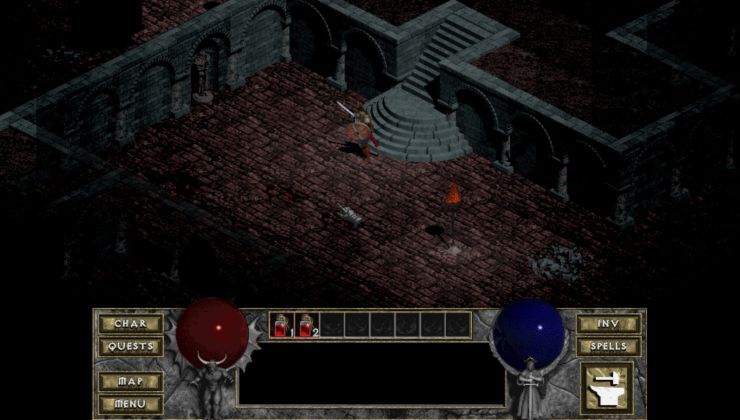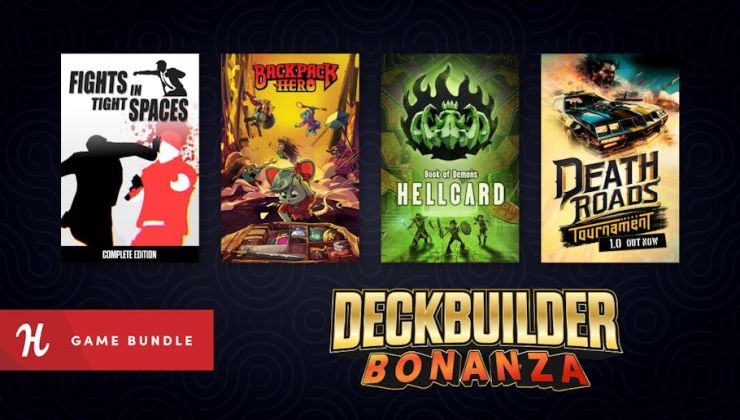The newest game from the developer of English Country Tune is now out. After a few days of playing and rolling dozens of sausages, I’ve got a few thoughts to share about this game and its puzzles.

Disclaimer: the developer sent GOL a key to cover the game.
A game about rolling sausages over fires to cook them doesn’t sound too appetizing when you first hear about it. Couple that with very low-key presentation and marketing and it’s easy to dismiss Stephen’s Sausage roll as some out-of-place curiosity. But, then again, the puzzle genre has always been more about substance than style. Even the sleek Antichamber and Talos Principle weren’t about the graphics; one of their main strengths was how problem-solving and the game world worked together. Nonetheless, as an admittedly not-too-hardcore puzzle game fan, I dove in with the game with no real expectations of what I was going to play.
The very bare bones approach of the game really works to its advantage. The controls are simplified to the extreme – just movements in four directions along with an ‘undo’ and ‘reset’ button. Armed with only an oversized fork, players are then expected to roll sausages over fires, cooking them on both sides without rolling them on an already-cooked part and burning them. Everything else in the game is up to the player to figure out. Not all at once, mind. And therein lies the game’s greatest strength: the puzzles are designed in such a way that in order to solve them you naturally experiment and pick up strategies and techniques as you go along. The rules of how movement and pushing works and how they can work are reinforced through small twists in each stage. Before you know it, things just click into place and you’re doing things that you would have never thought of doing when first starting out.
There is some degree of freedom in how puzzles are presented. The game is divided into zones each with a visual and mechanical theme. At first you leisurely roll by the seaside, then you skewer and hold elsewhere, then stack and roll in the snow and so forth. It’s a natural progression of complexity and, more importantly, keeps the game fresh after hours upon hours of puzzle solving. Players are free to solve puzzles in an area in the order of their choosing and so it’s implicitly encouraged to try out different things in different puzzles which may help you figure out things elsewhere. Once all the puzzles in the area are complete can players move on to the next, picking up tidbits of the minimal storytelling via inscriptions.
The puzzles themselves are fairly challenging. They require plenty of thinking ahead and, sometimes, outright experimentation. This isn’t a game that you can really binge play, I feel. I’ve spent several days playing on and off, often coming back to the game after inspiration struck about a puzzle I had trouble solving. I think it’s a fairly good sign for a puzzle game if you think about solutions even when you’re not playing and, at the very least, it’s a good way not to burn out. What surprised me time and time again was how fresh nearly every puzzle was and it didn’t ever feel like I was simply redoing the same thing over and over again on a larger, more tedious scale. The game never felt unfair either – when I couldn’t figure something out it wasn’t because it required a huge leap of logic, just a little more patience and tinkering.

One of the things that surprised me about the game was just how much content is packed into it. I’ve barely arrived at the fourth area after at least a dozen hours of playing (probably rather more, but I’ve been playing the DRM-free version and it’s hard to keep track of playtime). There’s a lot more ahead of me according to posts in the forums players who have finished the game already have mentioned it taking them at least 20-odd hours with reports of much more for some. So, unless you’re an absolute puzzle master, don’t expect to breeze through it. Since new techniques are added every world, there’s a constant gradual learning curve as well.
Not everything about this meaty game is as tasty as it could be, however. The audio component is definitely the weakest aspect of the game. The music is uninspired and the sound effects aren’t anything special either. After a few hours I turned both down and replaced it with my own library. Likewise, the graphics aren’t very attractive either. Personally, I think that the day/night cycle and some of the stylistic choices about the backgrounds and tiles work well, but the game isn’t eye candy by any stretch of the term; though it does look considerably better in motion than through static images. Finally, and most annoyingly perhaps, the controls do feel a bit clunky at times and do take a while to get used to. A fair amount of time is spent changing direction and walking backwards and even with all my hours into the game, I occasionally slipped up and pressed the wrong button, messing up the positioning of my sausage. This is offset by some extent by the infinite and immediate undo button which is an integral part of the gameplay.
All in all, Stephen’s Sausage Roll is an incredibly juicy game, its casing stuffed with clear love from its developer. This is a must-have for fans of serious puzzle games; no game in quite some time has made me feel, at times, so dumb and then so clever when I finally worked things out. Stages like The Great Tower are so incredibly satisfying to figure out that they completely made me forget about the game’s shortcomings. If you’re a casual player looking for instant gratification: stay away! You’ll be frustrated by the obtuse way the game is presented. If you’re looking for a strong story or something a little less nonsensical than playing with magical giant sausages, then you’re also in for some disappointment. But, if you can put aside the mediocre audiovisual elements and embrace the challenge, you’ll have an excellent time.
A final word caution however if you are thinking of picking it up: some Linux users reported some trouble getting the game to work, which may be an upstream Unity bug. I could only get the x86 binary to launch on my machine but otherwise encountered no other technical problems. The dev is responsive and seems to be keen on solving issues so I’m hopeful that these problems will be ironed out in no time.
You can grab Stephen’s Sausage Roll from its official site through a humble widget. You’ll get both a Steam key and DRM-free Humble Store version that way.

YouTube videos require cookies, you must accept their cookies to view. View cookie preferences.
Direct Link
Direct Link
Disclaimer: the developer sent GOL a key to cover the game.
A game about rolling sausages over fires to cook them doesn’t sound too appetizing when you first hear about it. Couple that with very low-key presentation and marketing and it’s easy to dismiss Stephen’s Sausage roll as some out-of-place curiosity. But, then again, the puzzle genre has always been more about substance than style. Even the sleek Antichamber and Talos Principle weren’t about the graphics; one of their main strengths was how problem-solving and the game world worked together. Nonetheless, as an admittedly not-too-hardcore puzzle game fan, I dove in with the game with no real expectations of what I was going to play.
The very bare bones approach of the game really works to its advantage. The controls are simplified to the extreme – just movements in four directions along with an ‘undo’ and ‘reset’ button. Armed with only an oversized fork, players are then expected to roll sausages over fires, cooking them on both sides without rolling them on an already-cooked part and burning them. Everything else in the game is up to the player to figure out. Not all at once, mind. And therein lies the game’s greatest strength: the puzzles are designed in such a way that in order to solve them you naturally experiment and pick up strategies and techniques as you go along. The rules of how movement and pushing works and how they can work are reinforced through small twists in each stage. Before you know it, things just click into place and you’re doing things that you would have never thought of doing when first starting out.
There is some degree of freedom in how puzzles are presented. The game is divided into zones each with a visual and mechanical theme. At first you leisurely roll by the seaside, then you skewer and hold elsewhere, then stack and roll in the snow and so forth. It’s a natural progression of complexity and, more importantly, keeps the game fresh after hours upon hours of puzzle solving. Players are free to solve puzzles in an area in the order of their choosing and so it’s implicitly encouraged to try out different things in different puzzles which may help you figure out things elsewhere. Once all the puzzles in the area are complete can players move on to the next, picking up tidbits of the minimal storytelling via inscriptions.
The puzzles themselves are fairly challenging. They require plenty of thinking ahead and, sometimes, outright experimentation. This isn’t a game that you can really binge play, I feel. I’ve spent several days playing on and off, often coming back to the game after inspiration struck about a puzzle I had trouble solving. I think it’s a fairly good sign for a puzzle game if you think about solutions even when you’re not playing and, at the very least, it’s a good way not to burn out. What surprised me time and time again was how fresh nearly every puzzle was and it didn’t ever feel like I was simply redoing the same thing over and over again on a larger, more tedious scale. The game never felt unfair either – when I couldn’t figure something out it wasn’t because it required a huge leap of logic, just a little more patience and tinkering.

One of the things that surprised me about the game was just how much content is packed into it. I’ve barely arrived at the fourth area after at least a dozen hours of playing (probably rather more, but I’ve been playing the DRM-free version and it’s hard to keep track of playtime). There’s a lot more ahead of me according to posts in the forums players who have finished the game already have mentioned it taking them at least 20-odd hours with reports of much more for some. So, unless you’re an absolute puzzle master, don’t expect to breeze through it. Since new techniques are added every world, there’s a constant gradual learning curve as well.
Not everything about this meaty game is as tasty as it could be, however. The audio component is definitely the weakest aspect of the game. The music is uninspired and the sound effects aren’t anything special either. After a few hours I turned both down and replaced it with my own library. Likewise, the graphics aren’t very attractive either. Personally, I think that the day/night cycle and some of the stylistic choices about the backgrounds and tiles work well, but the game isn’t eye candy by any stretch of the term; though it does look considerably better in motion than through static images. Finally, and most annoyingly perhaps, the controls do feel a bit clunky at times and do take a while to get used to. A fair amount of time is spent changing direction and walking backwards and even with all my hours into the game, I occasionally slipped up and pressed the wrong button, messing up the positioning of my sausage. This is offset by some extent by the infinite and immediate undo button which is an integral part of the gameplay.
All in all, Stephen’s Sausage Roll is an incredibly juicy game, its casing stuffed with clear love from its developer. This is a must-have for fans of serious puzzle games; no game in quite some time has made me feel, at times, so dumb and then so clever when I finally worked things out. Stages like The Great Tower are so incredibly satisfying to figure out that they completely made me forget about the game’s shortcomings. If you’re a casual player looking for instant gratification: stay away! You’ll be frustrated by the obtuse way the game is presented. If you’re looking for a strong story or something a little less nonsensical than playing with magical giant sausages, then you’re also in for some disappointment. But, if you can put aside the mediocre audiovisual elements and embrace the challenge, you’ll have an excellent time.
A final word caution however if you are thinking of picking it up: some Linux users reported some trouble getting the game to work, which may be an upstream Unity bug. I could only get the x86 binary to launch on my machine but otherwise encountered no other technical problems. The dev is responsive and seems to be keen on solving issues so I’m hopeful that these problems will be ironed out in no time.
You can grab Stephen’s Sausage Roll from its official site through a humble widget. You’ll get both a Steam key and DRM-free Humble Store version that way.
Some you may have missed, popular articles from the last month:
All posts need to follow our rules. For users logged in: please hit the Report Flag icon on any post that breaks the rules or contains illegal / harmful content. Guest readers can email us for any issues.
Thanks for the nice review. Seems like a solid puzzler despite the lacklustre presentation. I'd probably have skipped it entirely based on screenies and title alone.
0 Likes
They seriously need to do something about the way they present the game. Looked at the screenshots, watched the trailer, and still have no clue about how the game is played, or if there is any gameplay at all for that matter.
0 Likes
Thanks for the great review. Looks right up my alley. Did you play last year's Snakebird?
0 Likes







 How to set, change and reset your SteamOS / Steam Deck desktop sudo password
How to set, change and reset your SteamOS / Steam Deck desktop sudo password How to set up Decky Loader on Steam Deck / SteamOS for easy plugins
How to set up Decky Loader on Steam Deck / SteamOS for easy plugins
Oh and the name doesn't mean anything but coincidentally could be pronounced as "Buttery" which suits me just fine.
See more from me